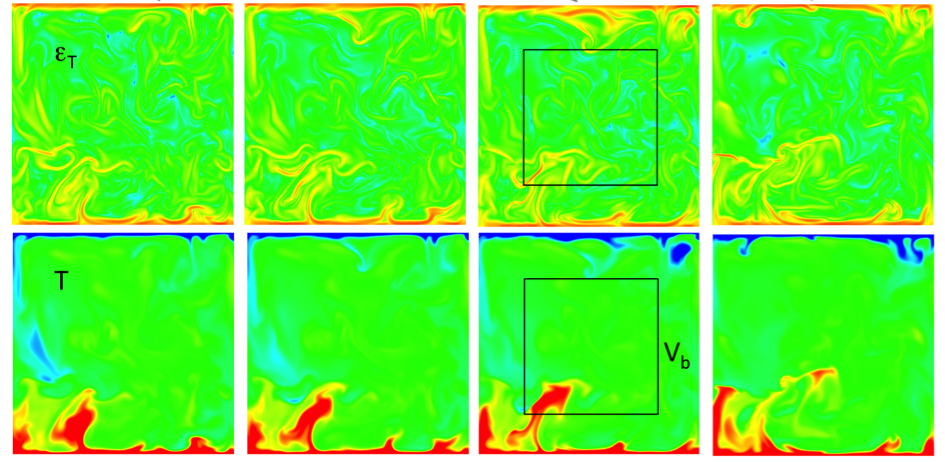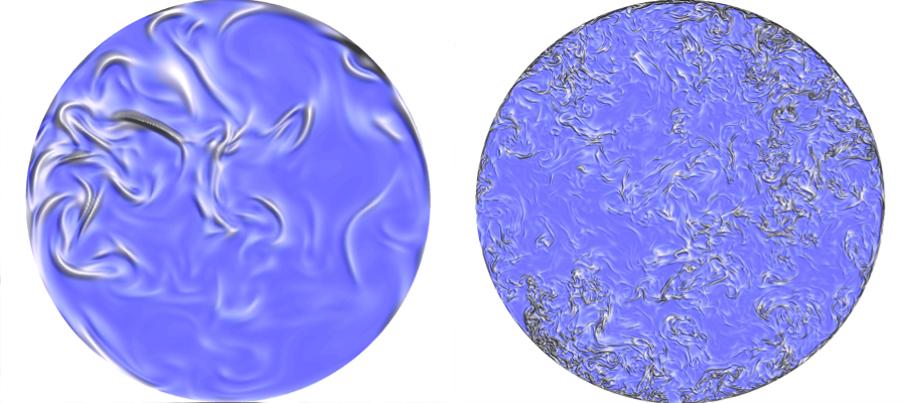ENGINEERING AND CFD
High-Amplitude Fluctuations of Velocity and Temperature Gradients in Turbulent Convection
Principal Investigator:
Jörg Schumacher
Affiliation:
TU Ilmenau (Germany)
Local Project ID:
hil07
HPC Platform used:
JUQUEEN of JSC
Date published:
An international team of scientists conducted high-precision spectral element simulations which resolved the fine-scale structure of turbulent Rayleigh-Bénard convection, in particular the statistical fluctuations of the temperature and velocity gradients.
Many turbulent flows in nature and technology are driven by sustained temperature differences. Applications reach from chip cooling devices, heat exchangers in power plants and energy efficient indoor ventilation systems via convection in the Earth's atmosphere or in its liquid metal core to convection inside the Sun and other stars. Although in most of these examples additional physical processes such as radiation or phase changes are involved, turbulent Rayleigh-Bénard convection (RBC) is the paradigm for all these convection phenomena and can be studied in a controlled manner. RBC still has enough complexity to contain the key features of turbulence in all the mentioned examples.
In RBC, a fluid cell is kept at a constant temperature difference between top and bottom plates. If the temperature difference is big enough, the fluid motion becomes turbulent. One of the key questions in RBC is that of the turbulent transport mechanisms of heat and momentum. Since the fluid is confined between rigid walls, tiny boundary layers of the temperature and velocity fields will form in the vicinity of the walls. The key for a deeper understanding of the global transport mechanisms lies thus in a deeper understanding of the complex physics in these boundary layers, their behaviour with increasing level of turbulence and their coupling to the turbulence in the interior of the cell, away from the convection cell boundaries.
In the framework of GCS Large Scale Projects, an international team of scientists conducted high-precision spectral element simulations which resolved the fine-scale structure of turbulent RBC, in particular the statistical fluctuations of the temperature and velocity gradients. The massively parallel simulations required up to 65,536 MPI tasks on the JUQUEEN supercomputer. A rare high-amplitude temperature gradient event is shown by a sequence of contour plots in Figure 1. In the lower row, a big hot plume is observed which rises into the interior (marked by the black box). The magnitude of the temperature gradient in the upper row highlights a steep front at the leading edge of the plume. The simulations quantified the impact of such extreme events on the global statistical properties, e.g. on the local variability of the turbulent heat transfer.

Figure 1: Vertical cross section through a convection cell displaying a sequence of temperature contour plots in the bottom row and the corresponding magnitude of the temperature gradient in the top row. The rise of a big hot plume (bottom row) and the corresponding high-amplitude temperature gradient front (top row) are shown. This is an extreme event in convective turbulence. The interior of the cell is indicated by the black box. Figure adapted from [1].
Copyright: Institute of Thermodynamics and Fluid Mechanics, Technische Universität IlmenauBy further analysing the gradients of the turbulent velocity field, the researchers found that the statistical fluctuations as quantified by higher-order moments share the same scaling properties as in other turbulent flows. These results provide a demonstration of the small-scale universality of turbulence which was postulated more than 70 years ago by the Russian mathematician A. N. Kolmogorov [2]. Figure 2 shows high-amplitude shear or kinetic energy dissipation layers in a horizontal cross section through the cylindrical convection cell. These are exactly the structures in which the velocity gradients are largest. The deeper understanding of the shear layers and their statistics in turbulence will help to improve the parametrizations of small-scale turbulence which are necessary in many numerical models of turbulent flows.
This research work was done together with colleagues from the United States, Janet D. Scheel from Occidental College, Diego A. Donzis from Texas A & M University, Katepalli R. Sreenivasan from New York University and Victor Yakhot from Boston University.

Figure 2: Shear or kinetic energy dissipation layers in turbulent convection. We display the horizontal mid plane for Rayleigh numbers of 5×107 (left) and 1010 (right). Both figures are for turbulent convection in air. With increasing Rayleigh number (a parameter which quantifies the turbulence level) the layers become finer and the gradients thus steeper.
Copyright: Institute of Thermodynamics and Fluid Mechanics, Technische Universität IlmenauPublications
[1] Janet D. Scheel, Mohammad S. Emran and Jörg Schumacher, Resolving the fine-scale structure in turbulent Rayleigh-Bénard convection, New J. Phys. 15, article no. 113063 (2013).
[2] Jörg Schumacher, Janet D. Scheel, Dmitry Krasnov, Diego A. Donzis, Victor Yakhot and Katepalli R. Sreenivasan, Small-scale universality in fluid turbulence, Proc. Natl. Acad. Sci. USA 111, 10961-10965 (2014).
http://inside.hlrs.de/#large-scale-order-and-small-scale-intermittency-in-turbulent-convection
Prof. Dr. Jörg Schumacher
Institut für Thermo- und Fluiddynamik
Postfach 100565
Technische Universität Ilmenau
D-98684 Ilmenau/Germany
e-mail: joerg.schumacher@tu-ilmenau.de
http://www.tu-ilmenau.de/tsm